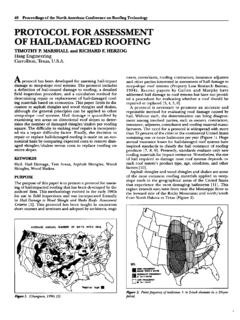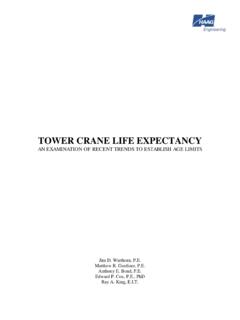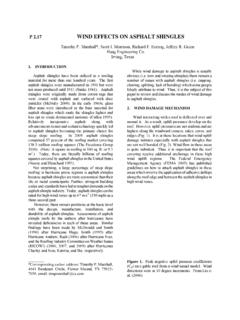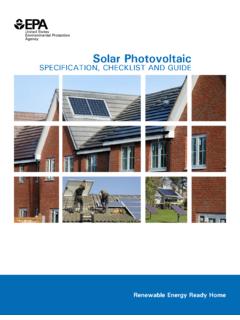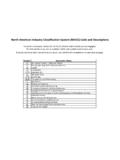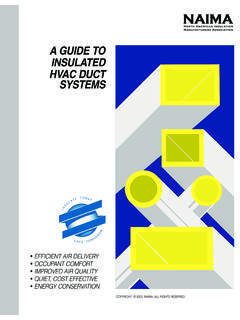Transcription of Proceedings of the North American Conference on Roofing ...
1 Proceedings of the North American Conference on Roofing Technology 41. The authors' firm has performed impact tests of many the mat. Bruises are soft areas large enough to be detected Roofing materials since 1963. The first study involved the by finger pressure and generally are accompanied by a suf- effects of hail damage to wood shingles and shakes. At the ficient loss of granules within the impact area to expose conclusion of the 10-year study, a summary of test results the underlying bitumen (Figure 3). Bruises in field shin- was published [12]. In 1983, the study was expanded to gles often occur in the less-supported areas of the shingles, include the effects of hail on asphalt shingles, fire-retar- such as along ridges, valleys, and overhanging roof edges dant-treated wood shingles and shakes, fiberboard panels, or above the tops of shingle head laps, (about 2 inches and aluminum panels.)
2 Meteorologists at the author's firm [52 mm]) from shingle butt edges). Our field experience have conducted storm surveys of major hailstorms and and laboratory testing have shown that punctures or bruis- developed software programs that search historical data es in asphalt shingles rarely occur with hailstones less than bases for hail -fall records and analyze the risk of damaging 1 inch (25 mm) in diameter, unless the shingle is poorly hail in the continental United States. supported and deteriorated. Generally, we find hard ice balls that impact perpendicularly can damage weathered ASSESSMENT PROCEDURE asphalt shingles when they are 1 1 4 inches (32 mm) in diam- The assessment procedure is based on determining eter and new shingles when 11 2 inches (38 mm) in diame- whether there is hail -caused damage and if so, quantifying ter [15].
3 Similarly, Greenfeld and Koontz have found that the amount of damage on each roof slope. It also involves impact-caused fractures in new shingles occur with ice determining whether repair of individual shingles or spheres in a range from 11 4 inches (32 mm) to 21 4 inches shakes or roof system replacement on an entire slope (or (58 mm) in diameter depending on shingle product and roof) is the economical choice. The first step is to inspect support conditions [16, 17]. Large hailstones produce mat the roof system and differentiate hail damage from non- fractures or bruises close to the diameter of the hailstone hail damage . Functional damage to Roofing materials from especially where the shingle has less underlying support. hail has been defined as the diminution of water-shedding In some instances, granules are dislodged from the shin- capability or reduction of the expected service life of the gles to expose bitumen without shingle mat rupture.
4 Minor Roofing material [13]. The second step is to quantify the granule loss caused by a hailstone impact that does not damage on each directional slope by examining test areas. result in the exposure of the shingle bitumen has not been The third step is to determine through a repair cost formu- found to cause any measurable loss of service life for the la whether repair or replacement of the Roofing material is impacted shingle [15]. Chipped shingle edges do not appropriate. shorten shingle service life and, hence, generally are not included in the shingle damage count. IDENTIFICATION OF hail -CAUSED damage Areas of shingles that have bitumen or mat exposed must be examined to determine whether the damage was Asphalt Shingles caused by hail or any other factors. Mechanically caused hail -caused damage to an asphalt shingle in Roofing is rup- marring of shingles during shipping, handling and installa- ture of the reinforcing mat or displacement of granules suf- tion can disturb the granule surfacing enough to displace ficient to expose underlying bitumen [14].
5 The former is a and expose bitumen. This is true particularly for warm penetration of the shingle that, in effect, removes a ply of fiber glass shingles subject to foot traffic on the roof. Mar- Roofing and has the potential for water to reach the fasten- ring results in a ridge of bitumen and granules at the ers or butted joints in the underlying shingle. The latter perimeter of the mark that is not found in hail -caused represents a potential loss of expected service life of the damage (Figure 4). Patterns of weathering or manufactur- shingle. However, we are not aware of any studies to date ing deficiencies can result in areas of little to no granule that have demonstrated a quantifiable loss of shingle life coverage on the shingles. Bundle variations should be rela- where the bitumen is exposed to the weather.
6 Tively easy to detect because the affected shingles would be Rupture of the reinforcing mat involves either bruising, arranged in diagonal or straight-up columns. In contrast, which can be felt as a soft spot on the shingle (much like exposed areas of asphalt caused by hailstone impact would an apple bruise), or puncturing where there is a hole in be roughly circular in shape and randomly distributed in the shingles. Blistering may appear as small bubblelike fea- tures in the granule crust whose tops weather away to leave pits in the shingles; the pits have steep sides and often extend to the mat. Granule flaking from old organic shin- gles can appear as areas of exposed bitumen that have a weathered gray color (Figure 5). Therefore, the overall condition of the shingles on the roof must be evaluated to differentiate between hail -caused damage and other types of damage .
7 A number of findings have been documented in our lab- oratory studies and confirmed in our field inspections of how impact-caused fractures in the mats weather [15]. The bitumen exposed in a recently caused hail impact will have a shiny black color. The bitumen weathers through photo- oxidation from a black to light-gray color over time. Figure 3. Bruise in a fiber glass composition shingle from hail impact. Impact-caused fractures in shingles initially have sharp 42 Proceedings of the North American Conference on Roofing Technology edges that, over time, weather to rounded forms. The over- dents, gouges) are not considered damaged. Long-term all size of the damaged area does not increase measurably natural weathering studies following impacts with simulated even after years of exposure. In fractured organic mat shin- hailstones have confirmed that impact marks without initial gles, the shingle mat will shrink and curl back from the splitting do not create a potential for future splitting [19].
8 Fractured area over a period of years. With fiber glass-rein- A hail -caused split in a wood roof system does not mean forced shingles, fractures widen but do not propagate visi- that a leak will occur at that split because there are addi- bly. tional layers of wood protection (and interlacing felt on a The author's firm conducted a study on asphalt shingles shake roof system); however, the potential for split align- that delineated hail -caused impacts from ball-peen ham- ments with other splits or joints between shingles or shakes mer impacts intended to simulate hail damage [18]. Ham- and loss of pieces of the shingle or shake justify classifying mer impacts usually involved crushing or breaking of the the split as damage requiring remedial work. A hail impact granule surfacing on the shingles whereas hailstone sufficient to puncture the wood, most commonly found in impacts do not.
9 Also, hammer impacts leave marks that are thin areas of shakes, also is damage because it involves the roughly the same size and shape regardless of roof slope, loss of one layer of Roofing . Impacts by hailstones do not whereas hail -caused impacts are of various sizes, shapes and affect the fire or moisture resistance of pressure-treated impact angles. Furthermore, people tend to cluster ham- wood or promote fungus or lichen growths or algae stain- mer impacts in the middle portion of the shingles or roof, ing. whereas hail impacts are distributed randomly on the shin- There are several characteristics that distinguish splits gles or roof. caused by hail impact from those due to natural weather- ing. A split due to hail impact will expose a bright, unoxi- Wooden Shingles and Shakes dized color on the entire fracture surface in contrast to the hail -caused damage to wood shingles and shakes is defined gray color of a weathered shingle or shake surface.
10 The as a split or puncture in the wood caused by hailstone edge of the fracture will be sharp, and the split will be coin- impact [12]. hail impacts in wood leave recognizable cident with a significant hail -caused impact mark. The impact marks where some of the gray-colored oxidation sharp-edged split can be pieced back together, and no and/or organic surface growths have been cleaned away. A shrinkage will be evident between the sides of the fracture. hail -caused split in the wood is indicated by an impact On occasion, a split can occur from hail impact that is not mark coincident with a fresh split in the wood (Figure 6). coincident with the impact mark, mainly when the signifi- Wood splits from hail impact occur at the moment of cant impact occurs at the edge of a cupped shingle or impact, and impacts that do not split the wood ( , spots, shake or the shingle or shake is supported unevenly by the underlying course.)

